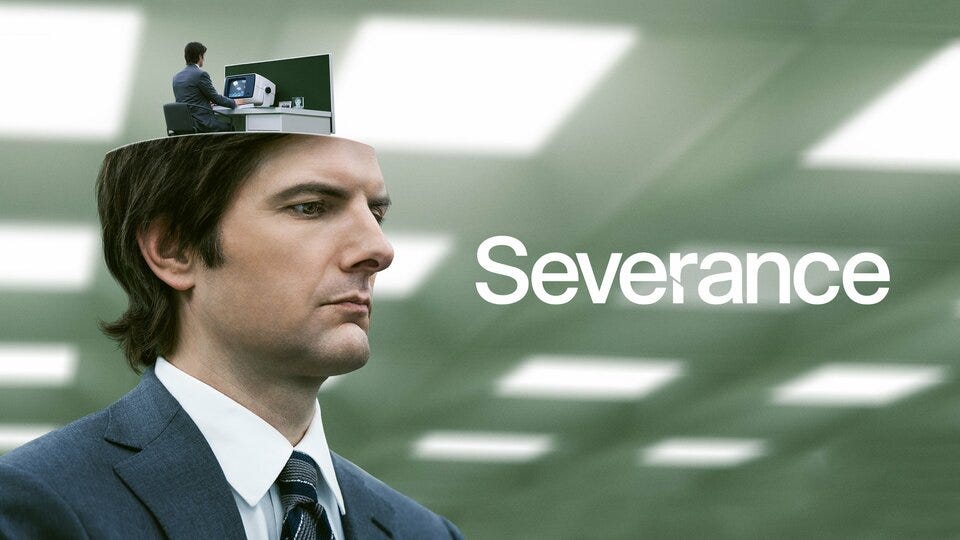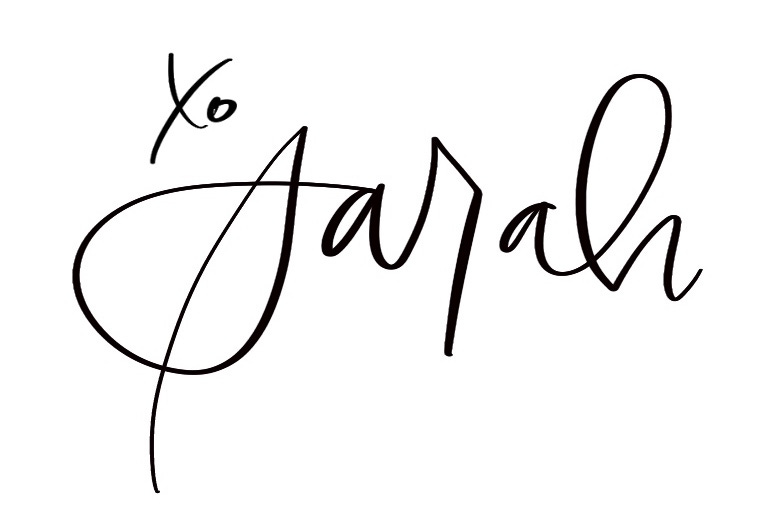Is your inner child trapped on the Severance floor?
What Severance can reveal about your inner child.
You may have noticed that there was no new Sex and Style piece last week — for the first time in two years, I took a week off to deal with a crisis. Thank you for your patience. Regular programming is resuming!
Sex and Style is written by me, Certified Sexologist and Somatic Sex Coach Sarah Ward. This is intended as general advice. If you’d like a personalized guidance, it would be a pleasure to hold space for you in a complimentary discovery session to support you where you are.
Warning: Spoiler alert. Proceed at your own risk!
If you want to skip the Severance bit and learn how this applies to you, scroll down to “The innie in all of us.”
Every time I hear the Severance theme song, I hear the Mission Impossible theme after it took a chill pill and sat down at the piano. Just me…?
If you haven’t watched it yet, the TV show Severance (Apple TV) follows the lives of Lumen Industries employees who undergo a procedure that splits their consciousness in two: a work “innie” and a personal “outie.”

One body; two identities.
On the elevator ride down each morning, their eyelids flutter, shifting their consciousness from outie to innie. At the end of the work day, the outie takes over and leaves the building, but for the innie, it’s like they never left.
At the end of the day, the elevator ride resets the clock for the innie, so it’s already tomorrow. No reset button, no rest, the fluorescent merry-go-round never stops. (Is this even ethical?? 😱 Elon Musk is not the person to ask, since he’s publicly advocated for 120 work weeks from his staff. Cool cool.)
In the first episode of Severance, we meet Helly R (played by Britt Lower) who wakes up on a conference table with no memory of who she is or how she got there. This is how we know the severed procedure was a success.
As you can imagine, existential identity crisis ensues.
In an interview with Britt Lower with Vogue Singapore1, she says:
“Helly is the catalyst who disrupts the status quo in the office and starts to ask questions. She’s acting as the audience surrogate, wandering around this building asking, what in the world is going on here? … She never hesitates to question authority, especially when it infringes upon her autonomy, humanity or free will.”
Part of a small Macrodata Refinement team, Helly’s presence inspires her fellow innies to act out against management and behave in defiant ways.
Submitting resignation papers
Attempting to escape
Making friends with other departments… after being fed propaganda that they’re murderous and not to be trusted
After trying to quit repeatedly, she’s turned down by a video from her outie Helena, who tells her point blank, “I am a person. You are not.” Oof.
To show just how serious she is, Helly takes matters into her own hands and attempts suicide in the elevator. Any damage that happens to their shared body becomes a collective wound.
Since these two different people share a body, it brings up the questions:
Who is real?
Who gets to decide who has rights and body autonomy?
Like children, the innie world view is black and white. They are developmentally young. One character measures how long he’s been at the company, calling it his fifth birthday.
The innies are a visual representation of the inner child. In them, we see an innocence and curiosity that’s endearing, and invites helicopter management; acting as the authoritative parents, monitoring them constantly and intervening often.
The resentment between the innies and outies cut like a knife:
The way that Helly can embody the tenacious traits that Helena could never.
How Helly yearns to be free and Helena denies her.
How Dylan’s wife is drawn to his innie, because he reminds her of early Dylan.
During one of their visits, Dylan’s wife and his innie kiss. “You’re cheating on me with my own body!”
“We all have an inner critic,” Britt Lower tells Vogue SG. “We all have an inner child. It makes sense that in [Helly], her inner critic has suppressed her inner child and rebel.”
The innie in all of us
“We all have parts—some young and wounded, others trying to manage those wounds—and all of them are doing their best to protect us. The inner child is often the exile: the part we had to lock away in order to survive.”
— Richard C. Schwartz, founder of Internal Family Systems
When our inner child is wounded — through abuse, neglect, shame, control, or a lack of safety — these wounds don’t just go away. They get buried in the basement of the psyche, like an innie on the severed floor: cut off from context, starved for autonomy, and looped in a kind of Groundhog Day, waiting for acknowledgment and care.
Severance is a beautiful allegory of grief and the lengths we take to avoid our feelings.
Mark, who lost his wife Gemma in a car accident, and later his job at the university after showing up to work drunk, joins Lumen to escape the grief. He starts to live like she never existed, moving to a new home and packing up all the memories of her in his basement.
But as the saying goes:
What we resist persists.
When we are willing to feel the unfelt feelings in ourselves, meet the parts of us that we repressed or disallowed, there is the promise of becoming a whole, integrated self — like Severance alludes to.
You may be wondering…
What does the inner child have to do with sexuality?
There are young parts of us that learned:
what was safe
what was allowed
what had to be hidden
what had to be split off to survive
Many people I work with have a memory of a parent catching them in the act of masturbating, and their parent shaming them for it.
I have a very clear memory from my childhood, and chances are you do, too. Here’s some of the things you might have heard around those early experiences:
“God is watching you.”
“You’ll go blind.”
“That’s disgusting.”
“Good girls/boys don’t do that.”
“You should be ashamed of yourself!”
While our adolescent brains are still developing, we take things very literally. These messages can trigger a life of disconnection from the body, guilt, and confusion.
“Masturbation is our first and natural form of sexual activity and if that's inhibited or damaged, then we suffer for the rest of our lives.”
—Betty Dobson
In these experiences, pleasure becomes imprinted in the brain and nervous system as dirty, dangerous and something to conceal. When we’re young, we are like sponges.
These imprints linger in our cells — the body is your book of life, after all — until we can revisit these feelings, sequence the shame and start to write a new script.
If pleasure was shamed or punished, the body might crave connection, but not know how to receive it. Or we may chase pleasure compulsively, trying to rewrite the past.
Our erotic selves can get stuck in that moment of shame or silencing and not know the path forward. If you had a shocking or shameful sexual experience in your developmental years, there may be a part of you still frozen in that moment—waiting to be thawed, reclaimed, and brought back online.
To heal is to un-sever.
Contrary to popular belief, there is nothing wrong with you. This frozen, severed part of you doesn’t need fixing.
It needs reuniting. To be remembered — not just mentally, but somatically — in the body.
We all remember how Han Solo was frozen in Carbonite by Darth Vader in Star Wars V: The Empire Strikes Back. He was brought back by love and Princess Leia, someone who cared deeply and believed he could return. In your case, you’re both Solo and Leia. This is your rescue mission of love.
Healing means un-severing the self. Bringing our inner child out of the fluorescent void and into the light of day, where pleasure becomes possible: an essential part of being human.
Your erotic self doesn’t need fixing. It’s needs to be reunited, integrated back into the whole. This is the invitation to befriend the parts of you that you’ve disowned, giving them a voice and a place at the table.
Dear one, you don’t have to do it alone.
This is the kind of thing that I support clients with in my somatic sex coaching practice. If you’re curious what this looks like and if it could be beneficial for you, I would be honored to connect in a free discovery session. Schedule one today, and start the un-severing process.
What if the body was never wrong to begin with? What if your early instincts were leading you to become yourself — and discover what you were made for?
Sex and Style is written by Certified Sexologist, Somatic Sex and Style Coach, Sarah Ward. She has spent the last 20 years studying human sexuality and minted it in 2021, certifying in the VITA™ Methodology with Layla Martin, and as an Erotic Blueprints™ Coach with Jaiya. For a personalized path to pleasure, schedule a free call with Sarah.
I’m so glad you’re here. If something about this resonated with you, please press the heart ♥️ button to help other people discover it, too. If this was supportive for you, please consider becoming a free or paid subscriber to keep posts like this coming.











